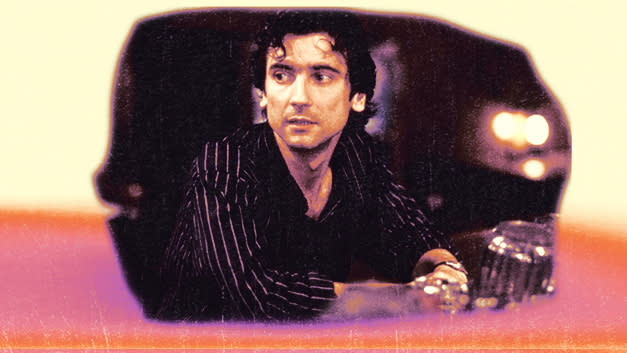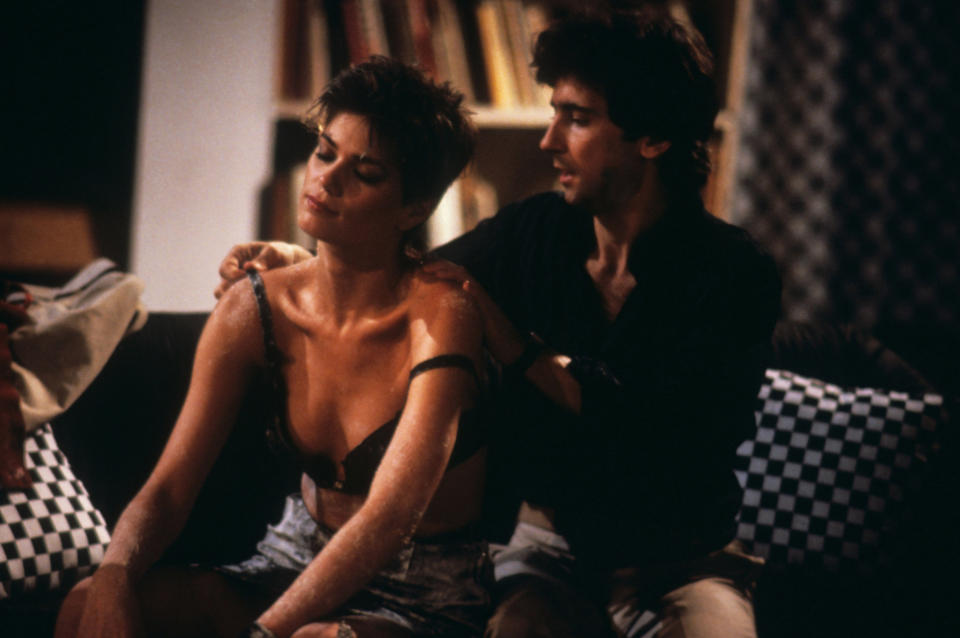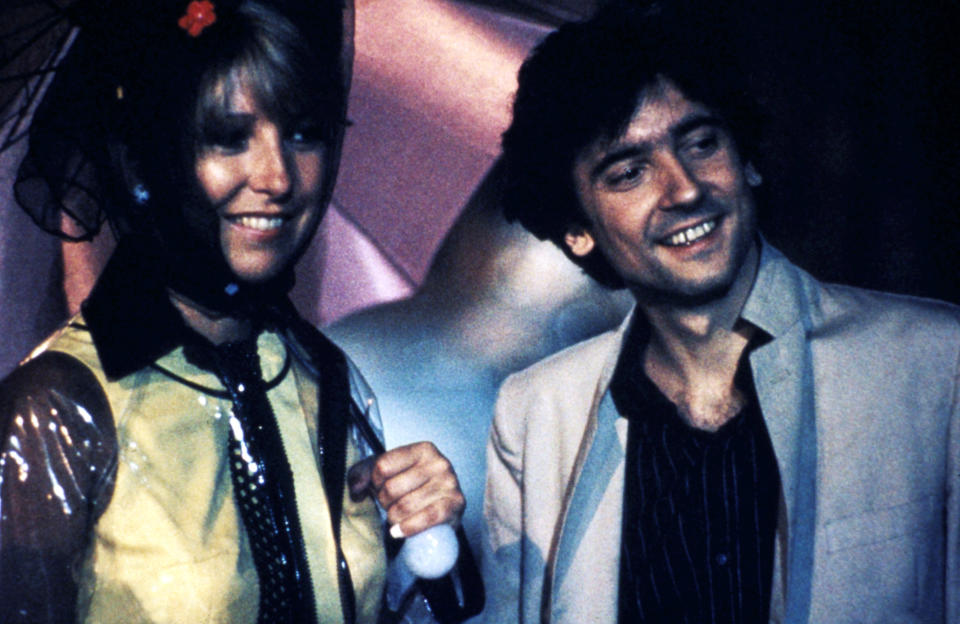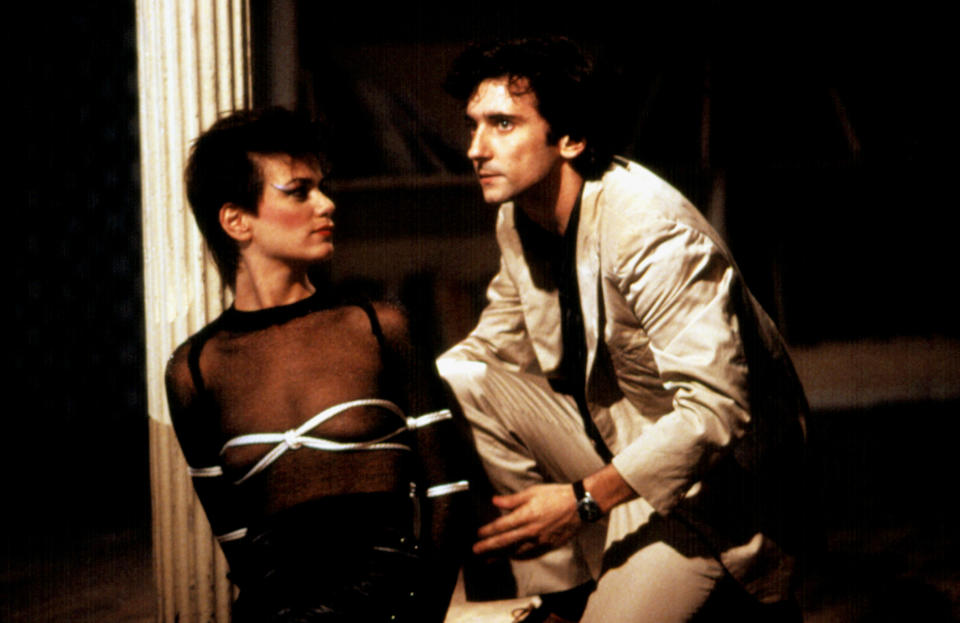Martin Scorsese’s ‘After Hours’ Paved the Anxious, Paranoid Road for the Safdies and ‘Beau Is Afraid’
- Oops!Something went wrong.Please try again later.
- Oops!Something went wrong.Please try again later.
- Oops!Something went wrong.Please try again later.
- Oops!Something went wrong.Please try again later.
- Oops!Something went wrong.Please try again later.


Forget “Annie Hall” or “Sex and the City.” For a certain generation of audiences, Martin Scorsese’s 1985 “After Hours” made you want to move to New York City.
“It’s like, wow, that place is so exciting and you never know what’s around the next corner and who I’m going to bump into and how I’m almost going to die and the subway fare will get raised in the middle of the night,” “After Hours” producer Amy Robinson said in a recent interview with IndieWire.
More from IndieWire
If you haven’t seen this existential screwball classic about paranoid android computer programmer Paul Hackett (Griffin Dunne) and his dark night of the soul in lower Manhattan, a more recent film serves as a useful retrospective primer: Ari Aster’s “Beau Is Afraid” and especially its Hieroynomous-Bosch-on-bath-salts first hour, set in a downtown hellscape spinning off the orbit of 40-something-year-old virgin Beau’s (Joaquin Phoenix) pathologically intrusive thoughts.
Similarly for the very square Paul, if the worst can go wrong in Scorsese’s classic, it will.
Played by Dunne as a desperately unlaid Freudian creature, Hackett is led through an ’80s SoHo underworld (on the cusp of the yuppie invasion) by an enviable ensemble of alluring and screwy women. They include Linda Fiorentino as a seductress plaster-of-Paris sculptor, Rosanna Arquette as Fiorentino’s quirky pollyanna roommate whom Paul meets in a diner at the start of his journey, Catherine O’Hara as an unhinged Mister Softee truck driver, and Teri Garr as a waitress who loves crooner Peggy Lee’s misanthrope anthem “Is That All There Is?”
All Paul wants, eventually, is just to make it back home uptown, maybe with some human touch along the way, but he loses his only $20 bill, the MTA raises subway fares in the middle of his journey, and he’s otherwise terrorized by the increasingly bizarre behavior of everyone around him as Scorsese, along with cinematographer Michael Ballhaus (who met Scorsese on this film) and editor Thelma Schoonmaker, whip up one nightmarishly slapstick misfortune after another. “After Hours” follows the logic of a dream impossible to retell because only you were in it, and it has no map.
Paul’s anti-hero’s-journey feels like a necessary forbearer to the pungent worlds of the Safdies’ “Good Time,” in which Robert Pattinson spends a manic night evading authorities in a neon-soaked New York City while encountering a host of grotesque individuals and life-or-death pratfalls funny for how much they hurt, or Aster’s aforementioned “Beau Is Afraid,” where Phoenix is also an undersexed man child just trying to get home.
While “Taxi Driver” and “Raging Bull” may be the most influential Scorsese movies of our time, given the unsavory and often sordid antiheroes we see on auteur TV, the dotted line from Scorsese to the paranoid palpitating heart of a film like the Safdies’ “Uncut Gems” (itself its own highly influential movie of our time) feels best inscribed by “After Hours.”
IndieWire spoke with star Griffin Dunne and producer Amy Robinson about the film, which Criterion recently re-released, and how it became one of the most influential movies of Scorsese’s career and the decade it dramatized.
The following interview has been edited and condensed for clarity.
IndieWire: “After Hours” is now regarded as one of Scorsese’s best movies, and that bar is obviously very high. The reception was mixed and even confused at the time, and it did so-so at the box office. Why are people returning to or discovering it now?
Amy Robinson: It’s accessible, funny, and terrifying, and I think that is very appealing to younger people.
Griffin Dunne: We are post-9/11, we are post-COVID lockdowns. Fear, paranoia, and terrible situations will eternally get laughs. When this movie came out, people weren’t used to seeing the two — anxiety and laughter, comedy — kind of mixed together, and it’s become a genre of its own since then. It’s just sort of timeless even though the neighborhoods have changed and people have cell phones and it’s much easier to get home and you can always get an Uber, and all that shit. As far as just the human conflict, and also the desire of going outside your comfort zone to have an intimate relationship with someone — in other words, get laid. That’s never going to stop happening either. Going down a rabbit hole in that is something that’s just universally funny.
Robinson: Younger people have said to me … [they watched it] … when they were 17, 18. A number of people said to me, “It made me want to move to New York.” Even though these terrible things happen to him, it’s like, wow that place is so exciting and you never know what’s around the next corner and who I’m going to bump into and how I’m almost going to die and the subway fare will get raised in the middle of the night. And it seemed to make people want to come to New York.

Amy, how did you go from starring in Scorsese’s debut feature “Mean Streets” to producing “After Hours” over a decade later?
Robinson: I wouldn’t call myself starring. I would say Harvey Keitel and Robert De Niro starred in the movie, and they became stars from the movie. I just found that my acting career wasn’t particularly going that well, and I also had this bent for reading and thinking about things that might make for good movies. I bumped into Griffin and another gentleman who was also an actor, Mark Metcalf, and we decided to option a book called “Chilly Scenes of Winter.” It’s a wonderful movie, and we were lucky enough, even though we were neophytes, to have experience in the business to get it made. I found that getting started from the very beginning and going all the way to the end was a much more satisfying career path for me.
Scorsese was also a bit in “director jail” at the time, traumatized by everything going wrong with “Last Temptation of Christ” and with the commercial failure of “The King of Comedy” three years before. What kind of state did you find him in?
Dunne: Besides loving the script and finding the humor, Amy was the one who thought of Marty for this, which a lot of people would not have thought of Martin Scorsese for a comedy like that. He got it, it made him laugh. He was excited by the limitations of the budget and the amount of money that we had, and starting with a new crew, with a now-disbanded union we had at the time — and getting back to the urgency of a “Mean Streets” kind of situation. It excited him to work with a new DP like Michael Ballhaus, who we had worked with on [John Sayles’] “Baby It’s You,” a lot of the crew that he went on to make many movies with started on “After Hours.” He was just excited about diving in.
Robinson: He was a little bit in director jail, and he knew it, and Marty is a very powerfully strong human. I think he knew that doing this movie the way we did it and, as Griffin said, with a limited budget, if it worked, and he did everything that he normally does. He storyboarded everything. He worked very hard and he was very committed to it, and I think he said something very nice on the last day of shooting about us as producers and our partner, Bob Colesberry, who is deceased, that we brought [Scorsese] back to his love of filmmaking. I don’t want to pat ourselves on the back. He would have come back without us, let’s put it that way. But it was a very nice thing and very moving thing for him to say.

Griffin, you had to live an ascetic lifestyle during the making of “After Hours.” Much like with Andrew Garfield on Scorsese’s “Silence,” you were asked to deprive yourself of sex and sleep.
Dunne: The things that both Paul Hackett and Garfield’s character had in common were they hadn’t been laid in a very long time because [Garfield] is a priest and me because I’m a computer processor. Marty, he asked me so that he could get this sort of look of, I don’t know, hunger. He wanted it to be not casual. As Paul Hackett gets close to having a physical encounter with Linda Fiorentino or Rosanna [Arquette], he’s kind of quivering inside. This whole thing was driven, this whole evening, by sexual impulse, so he wanted me to maintain that tension and that hunger and awkwardness.
Robinson: As the producer, since Griffin was working all night, I had to have a guard outside his apartment doors so no women would go in there. That was a joke.
“After Hours” has been hugely influential for a number of millennial filmmakers who’ve hat-tipped it as a reference for their own anxiety-ridden work. Have you seen Ari Aster’s “Beau Is Afraid”?
Dunne: I have not seen that, but I have heard several filmmakers, we were just talking about the Safdie brothers earlier, I’ve heard other filmmakers talk about the influence “After Hours” on whatever particular movie they’d recently made, which is always very flattering.
This film takes place entirely at night, which means you were sleeping during the day behind boarded-up windows and had to really learn how to be nocturnal while shooting in the dark.
Robinson: I worked a little bit more splits some days because I had to go to the office. I’m a night owl anyways, so I’d stay at the set until three in the morning and then maybe go home and sleep and go to the office. Most nights, we were all there all night long. It was the days when SoHo was deserted, and there were always rats running around our feet, and we were sitting out there, and it was great.

There is such an effortlessness to the movie that speaks to Scorsese’s confidence, but the hardest moments to pull off, I imagine, were things like the $20 bill flying out the cab window or Kiki (Linda Fiorentino) dropping a key down to Paul from her apartment window.
Robinson: The key drop is the classic story. Griffin mentioned our trepidatious camera crew. We theoretically couldn’t afford a crane. They made a platform with a hole in it for the camera and it went up on the top of that building where Kiki lived, and they were dropping it on the street with mountain-climbing ropes, and it was going to come down right over Griffin’s head and not hit him and kill him. That’s how we were going to shoot the key drop, and we did.
The ropes were smoking, and the thing came down. I was actually sitting next to Marty, I said, “We can’t do that again. That’s really dangerous. We can’t do it. It came this close to his head.” Marty said, “I think you’re right,” which was unusual. We went to dailies, and it didn’t work. He was not happy with the shot. Bob Colesberry was able to find a little money in the budget and was able to buy a crane, or rent a crane, for a couple of hours and then we were able to do the key drop shot. We all know about accidents on sets, and we were just incredibly lucky that Griffin is with us.
The original ending saw Paul Hackett trapped in a papier-mâché sculpture made by Verna Bloom’s character, June, unable to escape his doomed evening. It instead closes with Paul breaking out of the plaster and back at work in a Mobius-strip kind of ending. There was even another idea where June … gave birth to Paul? Were there any other wacky ideas tossed out?
Dunne: I don’t remember outside of the outrageousness of hiding inside the womb of Verna Bloom and then coming out as a wet placenta. It was such an outrageous idea it overshadowed whatever other ends were spitballing.
Robinson: When we screened the movie, and the way the script ended, and [screenwriter Joseph Minion] wasn’t sure what the ending should be either, it was just Griffin in the back of the van, and you saw his eyes going back and forth, and you would never know what would happen to him. When we did some test screenings, it was just too upsetting to the audience, that he was in limbo for the rest of his life or gonna die in there in the back of Cheech and Chong’s van. The ending of going back to the beginning, and the circularity of it, it just made a lot of sense in that I loved the way Griffin plays the scene … when he goes back into the office with the plaster, he has a kind of dignity he didn’t have in the beginning of the movie. He has been through it all, he’s going to work, he’s covered in plaster, he gets there on time.
Griffin, how long did you spend in that plaster during filming?
Dunne: I was in it for quite a while, and once you’re in it, you’re in it. You can’t just take it off. I remember Ric Ocasek dropping by the set, from The Cars, I think Marty was thinking he could possibly do the music. I remember being inside the sculpture, and Marty going, “This is Ric Ocasek,” and I’m going, “Hi, nice to meet you, I’m a big fan,” but I’m inside the sculpture. When are we gonna shoot this thing? Get me out of here. I always equate Ric with being in that sculpture. He had to crouch down to talk to me.
Best of IndieWire
Sign up for Indiewire's Newsletter. For the latest news, follow us on Facebook, Twitter, and Instagram.

